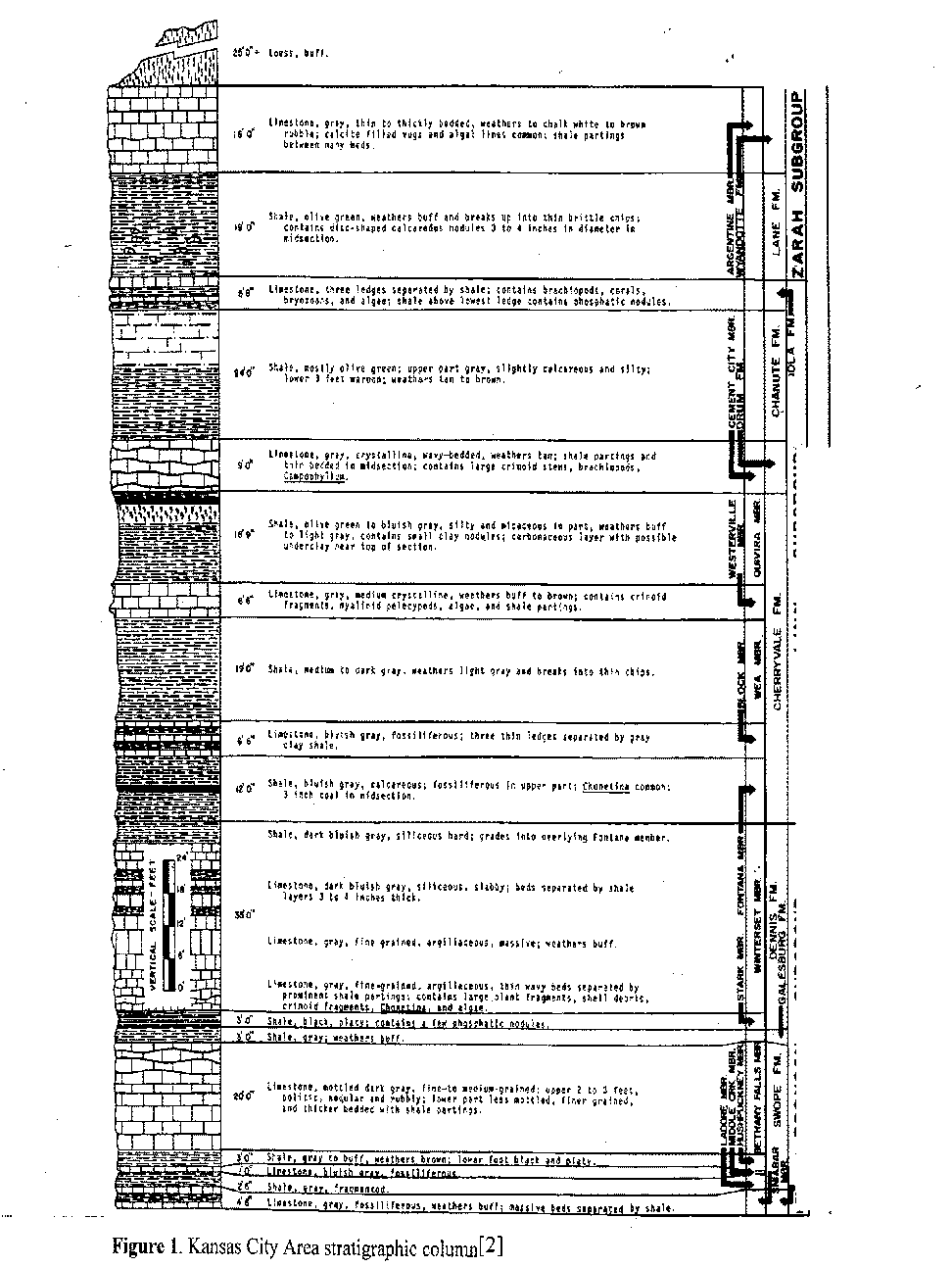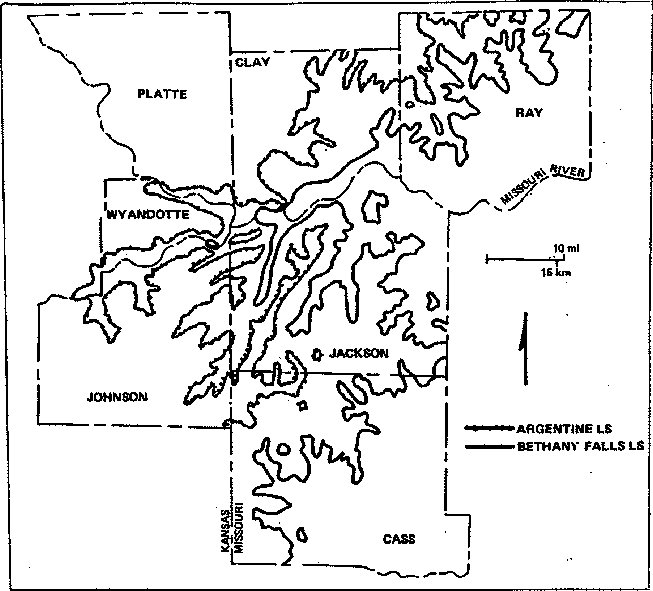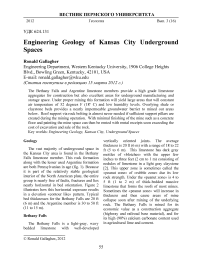Engineering geology of Kansas city underground spaces
Автор: Gallagher Ronald
Журнал: Вестник Пермского университета. Геология @geology-vestnik-psu
Рубрика: Инженерная геология, мерзлотоведение и грунтоведение
Статья в выпуске: 3 (16), 2012 года.
Бесплатный доступ
The Bethany Falls and Argentine limestone members provide a high grade limestone aggregates for construction but also excellent areas for underground manufacturing and storage space. Under proper mining this formation will yield large areas that will constant air temperature of 52 degrees F (18 o C) and low humidity levels. Overlying shale or claystone beds provides a nearly impermeable groundwater barrier to mined out areas below. Roof support via rock bolting is almost never needed if sufficient support pillars are created during the mining operation. With minimal finishing of the mine such as a concrete floor and painting the mine space can then be rented with rental receipts soon exceeding the cost of excavation and sale of the rock.
Engineering geology, kansas city, underground spaces
Короткий адрес: https://sciup.org/147200830
IDR: 147200830 | УДК: 624.131
Текст научной статьи Engineering geology of Kansas city underground spaces
(Статья поступила в редакцию 15 марта 2012 г.)
The Bethany Falls and Argentine limestone members provide a high grade limestone aggregates for construction but also excellent areas for underground manufacturing and storage space. Under proper mining this formation will yield large areas that will constant air temperature of 52 degrees F (18 o C) and low humidity levels. Overlying shale or claystone beds provides a nearly impermeable groundwater barrier to mined out areas below. Roof support via rock bolting is almost never needed if sufficient support pillars are created during the mining operation. With minimal finishing of the mine such as a concrete floor and painting the mine space can then be rented with rental receipts soon exceeding the cost of excavation and sale of the rock.
Key worlds: Engineering Geology, Kansas City, Underground Spaces
Geology
The vast majority of underground space in the Kansas City area is found in the Bethany Falls limestone member. This rock formation along with the lesser used Argentine formation are both Pennsylvanian in age (fig. 1). Because it is part of the relatively stable geological interior of the North American plate, the entire group is nearly free of faults, fractures and lies nearly horizontal in bed orientation. Figure 2 illustrates how this horizontal exposure results in a elevation «contour like» pattern. Typical bed thicknesses for the Bethany Falls are 20 ft (6 m) and the Argentine member is 30 to 50 ft (11 to 15 m).
Bethany Falls
The Bethany Falls is a light-gray, wavy bedded limestone with well-developed vertically oriented joints. The average thickness is 20 ft (6 m) with a range of 18 to 22 ft (5 to 6 m). This limestone has dark gray mottles of «blotches» with the upper few inches to three feet (2 cm to 1 m) consisting of nodules of limestone in a light gray claystone [2]. This upper zone is sometimes called the «peanut zone» of «rubble zone» due its low rock strength. Under the «peanut zone» is 4 to 5 ft (1 to 2 m) of thick-bedded massive limestone that forms the roofs of most mines. Sometimes the «peanut zone» will increase in thickness and then cause areas of mine collapse soon after mining of the underlying rock. The Bethany Falls is mined for its economic value as a construction aggregate (highway and railroad base material), and for its high (90%) calcium carbonate content used in agricultural lime and cement.

|нёч1НА Ш-BRONSON SUBGROUP ______|______________ LINN SUBGROUP
_________________________ KANSAS CITY GROUP
Above the Bethany Falls «peanut zone» is 3 feet of dense, impervious claystone that forms an excellent barrier of downward migration of groundwater. This is a major reason why the underground spaces are so unusually dry. Below the Bethany Falls is the Hushpuckney Shale that is source of problems in some mines. This shale will absorb water and then cause warping or heaving of the mine floors by several inches between pillars after several years of exposure [1]. The Hushpuckney is a medium gray to black fissile shale high in heavy element such as sulfides and phosphates and about 4 feet thick. This heaving could be caused by:
-
a) pressure release from removal of the overlying Bethany Falls;
-
b) pressure exerted by the growth of gypsum crystals lenses in the shale laminations;
-
c) weight of the adjacent pillars and associated column loads;
-
d) expansion of the shale by water absorption.
Most mine owners will remove the Hushpuckney to prevent so such problems and also gain additional clearance for large railroad cars and trucks to enter the mine. Under the Hushpuckney is the Middle Creek Limestone that is hard and strong rock. In such areas the bases of pillar must have a concrete collar to prevent water entry in the remaining Hushpuckney in the base of the pillar.
Argentine Limestone
The Argentine Limestone is stratigraphically about 150ft (46 m) above the Bethany Falls Limestone. Generally it is 50 ft (15 m) and grading down to 35ft (11 m) in thickness in the Kansas City area. The upper most portion is a uniform light gray limestone and then grades downward into thin and wavy beds of limestone and clay seams. The overlying Island Creek Shale is relatively impermeable and provides a seal to downward groundwater movement. (fig. 3).

Figure 2. Outcrop bands of Bethany Falls and Argentine Limestone members (AMG, 1994).
|
HAMED UNITS |
ROCK SECTION |
inivr (FT| |
к vCK DESCRIPTION |
GEOTECHNICAL PROPERTIES |
|||||
|
ж 111 от « 2 < 2 « > > W z 2 Ш A. |
0. Э о к о и от * от 2 & |
X о 1-< S X о U. ш t- 1- о о X < > ? |
ISLAND CREEK SHALE MEMBER |
а^^м—. Imm mr 411111141 ■>»<
winmi»
—■■ ■ i
w
*» и— |
250 |
SHALE, med-gray |
impermeoble;forms still; prevents water seepage Into mine |
||
|
argentine LIMESTONE MEMBER |
till |
20.0 |
LIMESTONE,blocky LIMESTOM, ILgray, thin wavy bidig clay seams |
roof commonly reinforced with root bolts |
|||||
|
1- |
-p -r1 1. 1--г |
||||||||
|
1 1 __U, |
|||||||||
|
LIMESTONE MINED |
|||||||||
|
QUINDARO \ SHALE MBR. |
|||||||||
|
* ■<—M <■—■• *»*■< 111 —— |
1Л |
SHALE.med- ara»........ |
.Mlt_______ |
||||||
|
ERI SB IE LS. MBR |
2.0 |
LIMESTONE, It. gray, fossils |
stable floor(uneven upper surface |
||||||
|
2 Ц. от 2 |
------- «V—— '■ III— — ................. |
28-0 |
SH^LE, med.gray, |
easily excavated; soft,unstable if wet |
|||||
Figure 3. Argentine Limestone stratigraphic column (AUG, 1994).
Sometimes miners of the Argentine Limestone will leave a few feet to act as a mine floor. In some location where there are thinner formations of Argentine Limestone miners will remove underlying and approximately 9 inches (0.35 m) thick Quindaro Shale in order to have hard and more durable floor of the Frisbie Limestone (AMG, 1994). To prevent swelling and destruction of the Quindaro Shale by water at the base of the support pillars 1 to 2 inches (2–4 cm ) concrete cover is places round the pillar base. The Frisbie Limestone is about 2 ft (0.75 m ) thick, hard and massive which provides an excellent supporting surface for railroad tracks and truck roads in the mine.
Engineering geology of the underground spaces
Mining of the spaces began about 1900 and by the 1950’s nearly 4.5 sq.mi (12 sq km) was available at 24 different mine site within 25 miles (40 km) of the Kansas City area. Since the mine entrances are usually at ground level direct access by truck and rail car made it easy to use the underground spaces. Most mines also left about 25% of the rock in place to provide long term supports for the overburden strata for two reasons. First, the mine remained a stable and sudden collapse was avoided and permitted later reuse for the space. Secondly, if too little rock was left for support and mine collapse occurred then the overlying surface topography will be a hummocky, unstable and therefore too irregular for construction of buildings. Furthermore as the value of the space was more appreciated the supporting pillars were better arranged into linear patterns that result in long clear spaces that are more useable for various reasons. Pillars are approximately 25 ft (8 m) in diameter and represent 22 to 25% of the original rock. The pillars are space from 50 to 55ft (16 m) apart. In the Argentine limestone the upper 6 to 7ft (2 m) is left to provide roof support. In many areas the ceiling is roof bolted consisting of #7, grade 60, rebar bolts 57 to 72in (145 to 183 cm) long and are fully grouted with Celtite polyester resin grout [1].
Список литературы Engineering geology of Kansas city underground spaces
- Geology and Underground Space in Metropolitan Kansas City, Missouri; Field Trip Guidebook for Annual Meeting, Association of Missouri Geologists, September 23-24, 1994.
- The Geology of the Kansas City Group at Kansas City by Eldon Parizek and Richard Gentile, Guidebook for Field Trip, Report of Investigation Number 31, Missouri Survey and Water Resources. Geological Society of America, 1965. 62 p.


